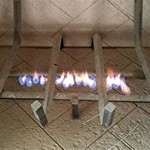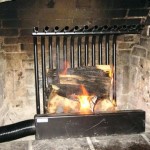Best Rated Gas Fireplace Inserts: A Comprehensive Guide
Gas fireplace inserts offer an efficient, convenient, and aesthetically pleasing way to upgrade an existing masonry or prefabricated fireplace. They provide a controlled burn, eliminate the need for wood storage, and significantly reduce the risk of chimney fires compared to traditional wood-burning fireplaces. Selecting the best-rated gas fireplace insert requires careful consideration of several factors, including heating capacity, efficiency, venting requirements, aesthetic design, and safety features. This article provides a comprehensive overview of gas fireplace inserts, highlighting key considerations for prospective buyers.
A gas fireplace insert is essentially a self-contained unit designed to fit inside an existing fireplace opening. They operate by burning natural gas or propane and venting the combustion byproducts through a flue or chimney. Unlike open-hearth fireplaces, gas inserts offer significantly improved heating efficiency, as they are closed systems that minimize heat loss up the chimney. This translates to lower heating bills and a more comfortable living space during colder months. The units are typically controlled via remote control or thermostat, allowing for precise temperature regulation and ease of use.
Understanding Heating Capacity and Efficiency
The heating capacity of a gas fireplace insert is measured in British Thermal Units (BTUs). A BTU is the amount of heat required to raise the temperature of one pound of water by one degree Fahrenheit. The BTU rating of an insert indicates its potential heating output. When selecting an insert, consider the size of the room you intend to heat. A small room may only require a 20,000 BTU unit, while a larger open-plan space may necessitate a 40,000 BTU or higher unit. Over-sizing the insert can lead to overheating and discomfort, while under-sizing will result in inadequate heating.
Efficiency is another crucial factor to consider. Gas fireplace inserts are rated for their efficiency as a percentage. This percentage represents the amount of fuel that is converted into usable heat. A higher efficiency rating translates to lower fuel consumption and reduced energy costs. Look for inserts with efficiency ratings above 70% for optimal performance. Some high-efficiency units can achieve ratings of 80% or higher. These units often incorporate features such as sealed combustion and modulating gas valves to maximize heat output and minimize fuel waste.
Furthermore, understanding the difference between natural gas and propane is crucial. Natural gas is typically plumbed directly into the home via a municipal supply line, while propane is stored in a tank. The BTU content of natural gas is typically lower than that of propane, meaning that a propane insert may produce more heat for a given fuel consumption rate. However, the overall cost of fuel and the availability of connections should influence the choice between natural gas and propane inserts.
Venting Options and Installation Considerations
Proper venting is essential for the safe and efficient operation of a gas fireplace insert. Gas inserts require a venting system to expel combustion byproducts, such as carbon dioxide and water vapor, to the exterior of the home. There are two primary types of venting systems used with gas fireplace inserts: direct vent and B-vent.
Direct vent systems are the most common and generally considered the safest and most efficient option. Direct vent inserts draw combustion air from outside the home and vent exhaust gases directly outside through a sealed system. This eliminates the need to use indoor air for combustion, preventing drafts and maintaining indoor air quality. Direct vent systems can be vented horizontally through a wall or vertically through the roof, offering installation flexibility. The venting system typically consists of two concentric pipes, one for intake and one for exhaust, ensuring a closed and sealed system.
B-vent systems, also known as natural vent systems, use the existing chimney of the fireplace to vent exhaust gases. These systems rely on natural convection to draw air up the chimney. B-vent inserts are typically less expensive than direct vent models but may not be as efficient. Furthermore, B-vent systems are more susceptible to backdrafting and may require more frequent maintenance to ensure proper ventilation. Before installing a B-vent insert, it's essential to have the chimney inspected and cleaned to ensure it's in good working order.
Professional installation is strongly recommended for all gas fireplace inserts. An experienced technician will ensure proper venting, gas line connections, and electrical connections are made safely and according to local building codes. Incorrect installation can lead to carbon monoxide leaks, fire hazards, and reduced efficiency. Before installation, ensure the existing fireplace opening is properly sized and prepared to accommodate the insert. Some modifications may be necessary to ensure a secure and aesthetically pleasing fit.
Aesthetic Design and Features
Gas fireplace inserts are available in a wide range of aesthetic designs to complement various home décor styles. From traditional log sets to contemporary glass media, homeowners can choose an insert that matches their personal preferences. The appearance of the flame is also a key consideration. Some inserts feature realistic dancing flames that mimic the look of a wood-burning fire, while others offer a more modern and stylized flame presentation.
The firebox interior can also be customized with different liner options. Brick liners provide a traditional and rustic look, while reflective black glass liners create a striking and modern appearance. The surround of the insert, which covers the gap between the insert and the fireplace opening, is also available in various styles and finishes. Options include cast iron, brushed nickel, and painted steel, allowing homeowners to tailor the insert to their specific aesthetic needs.
In addition to aesthetic design, gas fireplace inserts often include a variety of features that enhance their functionality and convenience. Remote controls are a common feature, allowing users to adjust the flame height, temperature, and fan speed from the comfort of their couch. Some inserts also include programmable thermostats, which allow users to set specific heating schedules and automatically adjust the temperature based on the time of day. Integrated blowers can also improve heat distribution, circulating warm air throughout the room more effectively.
Safety features are paramount in gas fireplace inserts. Look for units with safety features such as oxygen depletion sensors (ODS) and automatic shut-off valves. An ODS monitors the oxygen level in the room and automatically shuts off the gas supply if the oxygen level drops below a safe threshold, preventing carbon monoxide poisoning. Automatic shut-off valves will also cut off the gas supply in the event of a malfunction or power outage. Regularly inspect the insert and venting system for any signs of damage or wear and tear. Schedule annual maintenance with a qualified technician to ensure the insert is operating safely and efficiently.
The selection of the best-rated gas fireplace insert is a decision that involves balancing factors such as heating needs, efficiency, venting limitations, aesthetic goals, and safety considerations. Thorough research and professional guidance are crucial for ensuring a satisfying and safe home heating experience.
.aspx?strip=all)
Top 11 Gas Fireplace Insert Trends Of 2024

Best Gas Fireplace Inserts Fireplaces Direct Learning Center

Best Gas Fireplace Inserts Fireplaces Direct Learning Center

Gas Burning Fireplace Inserts Sierra Hearth And Home

Gas Fireplace Inserts Pros And Cons Of Ventless Fireplaces

Best Gas Fireplace Inserts Fireplaces Direct Learning Center

Duluth Forge Dual Fuel Ventless Gasfireplace Insert 26 000 Btu T Stat Control Fdf300t Com

How To Buy A Gas Fireplace Insert Buyer S Guide From Regency

Best Gas Fireplace Inserts Fireplaces Direct Learning Center

Best Fireplace Inserts In 2024








